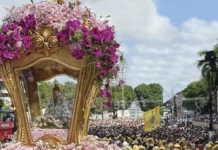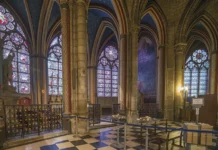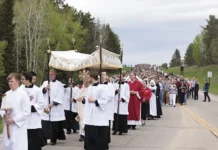 Benedictine nuns maintain perpetual adoration in Montmartre
Benedictine nuns maintain perpetual adoration in Montmartre
Initiated on August 1, 1885, Adoration of the Blessed Sacrament in the Basilica of Sacré-Cœur in Montmartre, France, has never ceased. “Even during the bombing of 1944, Eucharistic Adoration did not stop,” explained Sister Marie-Agathe of the Benedictine Sisters of the Sacred Heart of Jesus to La Croix.
Under present circumstances, with the basilica closed to the public, the religious of this congregation take turns day and night to ensure that there is always someone keeping vigil with Our Lord in the Blessed Sacrament.
“Being the only ones who can presently enter the basilica, it is up to us to continue perpetual adoration.” And she adds: “To continue this chain of prayer is our primary mission. The challenge is to maintain it, at this time, with only fourteen people.”
Atop the highest dome of the Basilica of Sacré-Cœur a lantern is permanently lit, witnessing to the perpetuity of the sublime act of worship practised there.
“It is a sign of communion for Parisians, a presence of continuity in prayer. If the prayer is interrupted, this lantern must be extinguished. Our mission during the confinement consists in ensuring that it is not extinguished,” concludes the nun.
Although most French churches remain open, the Basilica of Sacré-Cœur, one of the most visited sites in the French capital, after Notre-Dame Cathedral, has been closed since March 17.
Cardinal Besungu: everyone will render accounts for what they have done
Cardinal Fridolin Ambongo Besungu, OFM Cap, Archbishop of Kinshasa, capital of the Democratic Republic of the Congo, presided at a Holy Mass on the occasion of the 60th anniversary of the country’s independence.
During the sermon he recalled that Congo’s independence, while having been won with great sacrifice, was marked by the desire of the Congolese to occupy “the posts of the whites” so as to enjoy their benefits. “While other nations reflected on the meaning of independence and prepared people for its consequences, we in Congo dreamed of independence with emotion and passion, but irrationally,” he affirmed.
He expressed his view of the exercise of authority in the country: “We come to power to enjoy, not to render service to those under our responsibility, but to enjoy what the whites did. But they, while occupying their positions, were not just amusing themselves. They also worked, and understood the meaning of their work. We, on the other hand, have put aside service to others and have emphasized the notion of enjoyment.”
Concluding his homily, Cardinal Besungu recalled that “each of us will have to account to God: […] ‘What have you done for your country?’ This is the question that will be asked when we come before the Supreme Judge.”
Fire in Nantes: a symbol of our Faith damaged
The Bishops’ Conference of France published a communiqué on the July 18 fire in Nantes Cathedral, pointing out that following “the fire at Notre Dame in Paris, in April 2019, and the 1972 fire at this same Nantes Cathedral, it is not just a part of our religious patrimony that has been destroyed. It is also a symbol of the Catholic Faith which is broken, wounding the hearts of all those for whom these edifices are places of prayer, spiritual refuge, and landmarks for faith.”
At this tragic moment, the French prelates emphasize the need for the faithful to unite in prayer in support of the Catholics of Nantes.
On the day of the incident, firefighters discovered that the blaze had three sources, the main one being located close to the church organ, which was completely destroyed. Built by Girardet in 1620, the instrument had withstood the attacks of the French Revolution, the bombings during World War II and the 1972 fire, more serious than that of 2020. “It is impressive; it is an unimaginable loss,” lamented Fr. François Renaud, diocesan administrator.
From January to March 2019, the Bishops’ Conference of France report 228 “violent anti-Christian acts.” The French police confirmed that in 2018 there were 129 thefts and 877 incidents of vandalism at Catholic sites, mainly churches and cemeteries. These types of attacks quadrupled from 2008 to 2019.
Although France has suffered more attacks than any other country in Europe, the numbers are increasing across the continent.
More churches vandalized in the United States
A number of Catholic churches located in the United States, from Florida to California, were damaged by fire and vandalism during the month of July.
Police are investigating whether these criminal acts are related to the protests organized by the Black Lives Matter movement, during several of which statues of Christopher Columbus and St. Junipero Serra were toppled. Shaun King, one of the movement’s activists, even preaches the demolition of all images representing Our Lord Jesus Christ as a “white European” because, he says, this is a form of “white supremacy” and “racist propaganda”.
In Florida, for example, a man set fire to the vestibule of Queen of Peace Church while preparations were being made for morning Mass on July 11. After being arrested for attempted murder, arson and other charges, the culprit, Steven Anthony Shields, told investigators that his feat was “awesome” and that he was on a “mission”. Fortunately, the Catholic edifice suffered little damage.
San Gabriel Mission Church in California was almost completely destroyed after another fire that occurred on the same day. Two statues of the Blessed Virgin were also vandalized and burned between July 10 and 11.
Historic Church in California Elevated to Minor Basilica

On the feast day of its Patron Saint, July 15, the St. Bonaventure Mission in California was elevated to the category of Minor Basilica, becoming the first in the region. The Archbishop of Los Angeles and President of the United States Conference of Catholic Bishops, Most Rev. José Horacio Gómez, communicated the decision, an answer to the request made six years earlier by the mission’s pastor, Fr. Thomas Elewaut, to the Congregation for Divine Worship and the Discipline of the Sacraments.
Founded on March 31, 1782, the St. Bonaventure Mission was the ninth and last created by St. Junipero Serra. Its church is the second oldest in the three counties encompassed by the Archdiocese: Los Angeles, Ventura and Santa Barbara. There are approximately five million Catholics in the Archdiocese of Los Angeles, the largest in the United States.







